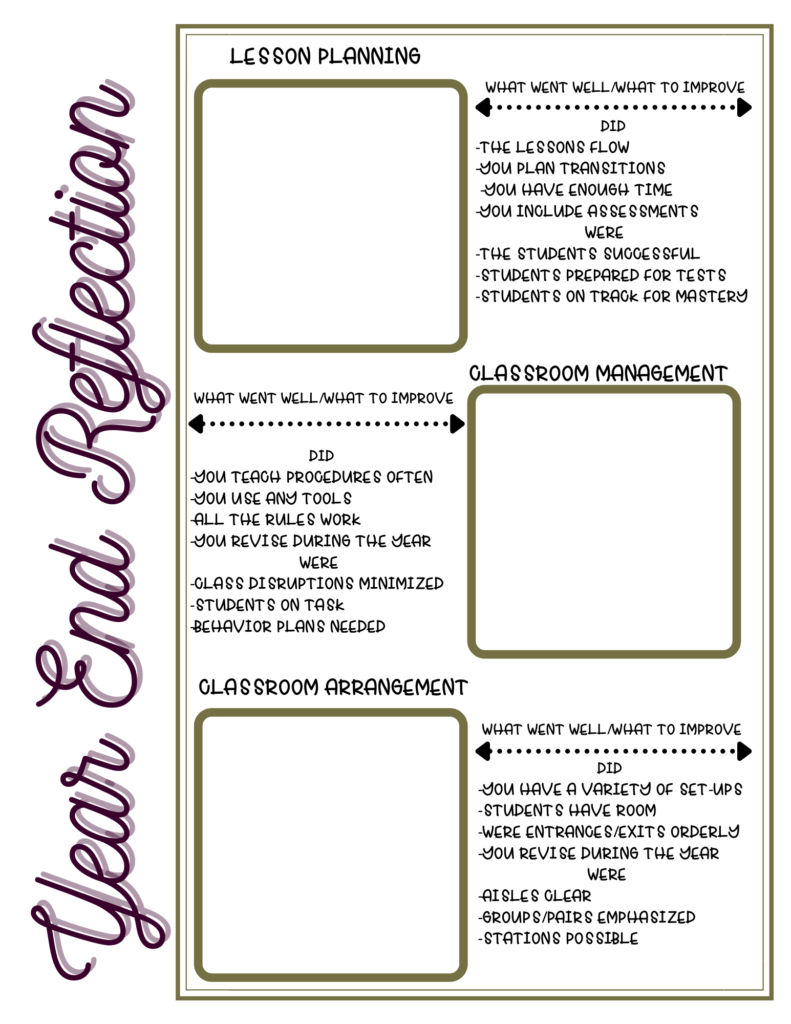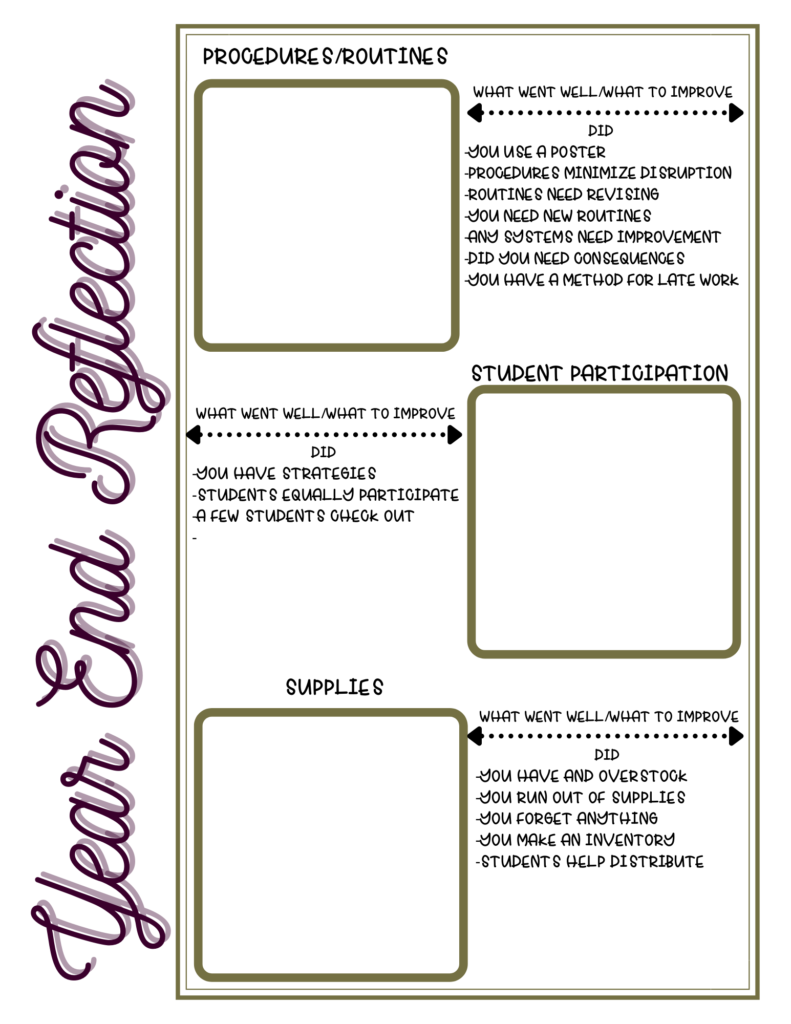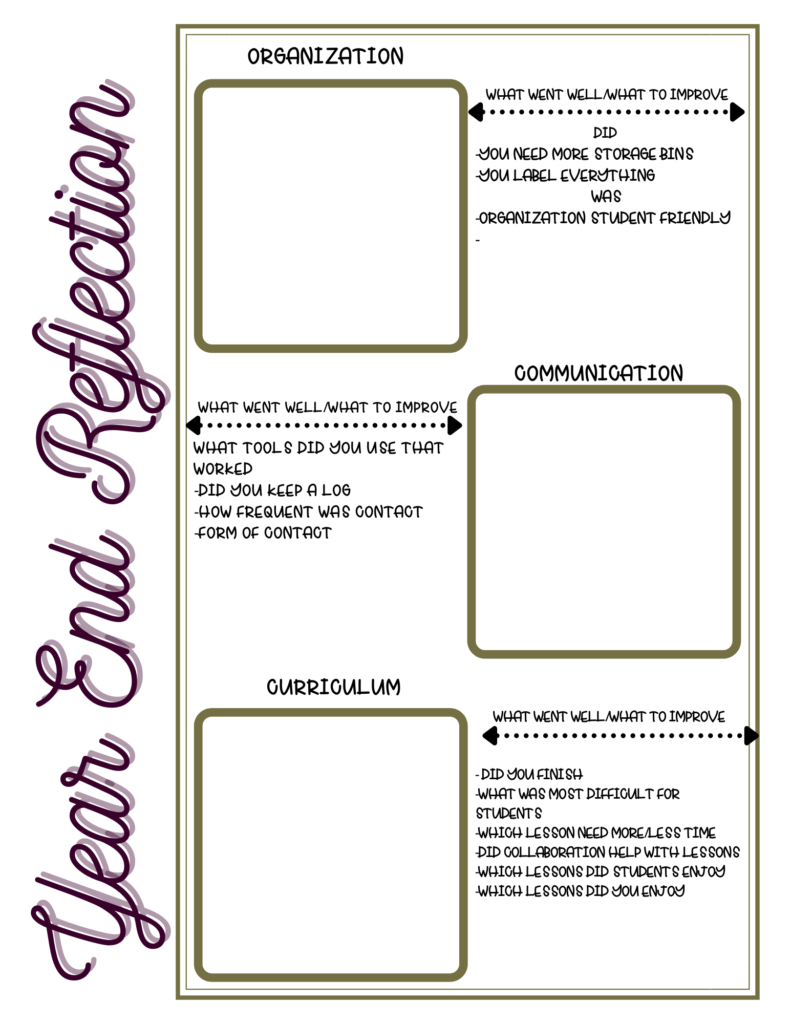One of the best parts of teaching is that you get a do-over each year. If you have a year that does not go well, you get to wipe away those challenges and start with a fresh slate at the beginning of the new school year. Of course, that is also true when you have a great year.

Starting over doesn’t mean starting from scratch. We all take some of the previous year with us and it helps to review at year-end when it is fresh in our minds what we can improve the next year, or continue with.
What Went Right
First think about all the things that went well. There are always more positives than negatives but I tend to focus on what I did wrong. Think about the following:
- Lesson Routines
- Family Communication
- Accommodations for Special Groups
- Collaboration with Other Teachers
- Lesson Planning
- Testing Procedures
- Classroom Management
- Curriculum Development
- Tools and Programs
- Professional Development
As you think about each of these areas, jot down the best ideas from each that you will continue. If you are changing grades, or courses you can still use these positives to morph into your new classes. Add any areas that I have not included.

After you have thought about those positives, think about what areas you want to improve. Go back to your list and think about how you will change your rules or routines to make your classroom better. Even if you classroom management was superior last year, when you begin a new year with new students, you may have to tweak your approach.
Classroom Management
Think about students and behavior that disrupted the class, whether your rules worked and if they did not, how they could be improved. Did you spend enough time teaching the rules, giving students concrete examples of behavior that was not acceptable?
Are you consistent the first few weeks or months to reinforce the rules? I know this is an area that I constantly work on. I get lax after a few weeks, and frustrated that students have “forgotten”. Consistency is definitely the key here.

Consequences
Are there consequences for breaking your rules? How do you handle students who refuse to follow your policies or procedures? Make sure any consequences are consistent with your school policy. And I tend not to have any consequence that will require me to give up my lunch period, stay after school, etc. It’s a personal preference and each of us is different.
How Do Students Participate
Do you want hands raised? Especially early in the year, students like raising their hands to participate. I like calling on students at random to make sure everyone participates so students raising hands doesn’t make sense. Sometimes I let the wheel of names choose the students, and other times I choose the first student and then that students chooses someone else to answer.
But this simple raising hands routine that students learned in elementary school frustrates students when they are not called-on in my class. They interpret this as “teacher is ignoring me”, “teacher doesn’t like me” or some other message that is unintentional. So explain your process. Explain that sometimes you will ask for hands to be raised and other times you will not.
Classroom Routines and Procedures
Start with the things that drive you crazy. Does it make you cringe to hear pencils sharpened all period? Are you overwhelmed with papers that have no names? Do students get up and wander around the class at will? Do they move desks out of order? Or do students leave supplies out, trash on the floor or personal belongings under the desks?
Thinking about your hot-points will help you determine which rules make your classroom function better. Some things to consider: How do students get pencils sharpened, get supplies, turn in work-both on time and late work, and get assignments when they are absent.
All of these questions should be answered in advance to make classroom run more smoothly. Post the procedures at least the first month. You will be repeating and correcting students often. You will have to reteach, repeat and perhaps revise the entire school year. You will be reminding them millions of times. It helps to have a poster to point to.

Supplies
Do you need to replenish supplies, markers, paper, etc. What about batteries. Make a list now and be ready for the next year. How are your supplies organized? Do you have trays for students to help themselves or do you put out baskets of supplies as needed. Do you have students to help get supplies, return them?
Think about not only the supplies you used, those you may have needed and how they are organized. I often have an abundance of supplies and much of it I don’t use often. Over the years I have purchased most of what I have and don’t want to declutter if I may use it later.
Once you have your supplies organized, try trading with a colleague to gain what you need and get rid of stuff you aren’t using. This works great especially if you are changing grades or courses. One year I moved from Algebra to Geometry. I traded some hands on equation sets for sets of protractors.
Classroom Set-Up
How your desks, chairs and tables are arranged can assist or interfere with everything else in the classroom. In my classroom, there is only one way to face the desks because I only have one white board in the room. The rest of the walls are bulletin boards. It is not convenient, but it is something I cannot easily work around.
So all my desks face the front. But I like to vary how the desks are arranged and rearrange them several times a year. The rows are sometimes single, sometimes doubled so every student has a partner, and other times in groups of 4. Even though my room is small for 36 students, by doubling the rows or making groups leaves more space for movement in the classroom.
Consider the function of the classroom. Can students easily navigate to get supplies, enter and leave the classroom, and can the teacher walk around to assist students without bobbing and weaving.
Curriculum and Instruction
Most of us have no control what curriculum the school or district will require teachers to use. But, we do have control how that curriculum will be delivered. The year of the pandemic taught us that there are always other ways to teach our content. When thinking about the past year consider which lessons fell flat and which were outstanding.
You can survey the students to see which lessons were difficult, which were fun, which were confusing, etc. Students can give insight, not necessarily to your teaching, but which content needed more in-depth coverage. If you are no longer in school, you can survey students at the beginning of the year. Ask them in the past what the teacher did to help them success when they were struggling with concepts.
What tools did you use to deliver lessons? Which activities were successful? Did you use online activities that helped students practice? Did you use notes or videos that students could review later? What formative assessments do you use to make sure students are progressing? How do you know when students are prepared for a quiz or test? All these questions can help you plan lessons more effectively and actually save time.
Communication
How did you keep in touch with students and their families? I have colleagues who use Remind to keep in touch with students. Others send emails. You can create a group of parent emails by class and send out weekly reminders. In the classroom you can send home grade checks for students to take home weekly as a reminder for parents. Include behavior or missing work as appropriate.
I have used Google Classroom for many years and like to post announcements and assignments, even if we are not doing digital work. Those announcements get emailed to students with every post.
How could you improve communication to save headaches later. It is difficult for a student or parent to say they were unaware of missing work or attendance issues when you have contacted them consistently.
The habit of reflection is a process to make continual improvement to our classroom and development as a teacher. Every day on the commute home, I reflect about what I did well and what could have been better.
If you would like the reflection sheets, both a pdf and editable templates, you can get them here. I love being in the classroom and I love being in a well run classroom where students are learning even more. Every year I strive to improve so that my students benefit from all the instructional minutes and focus on learning as well as having fun. I would love to know if you are a reflective teacher and what your process is like. Drop a comment or email me at [email protected].










Leave a Reply